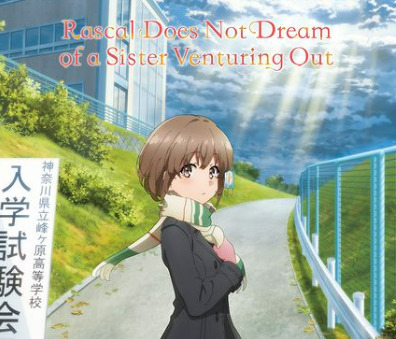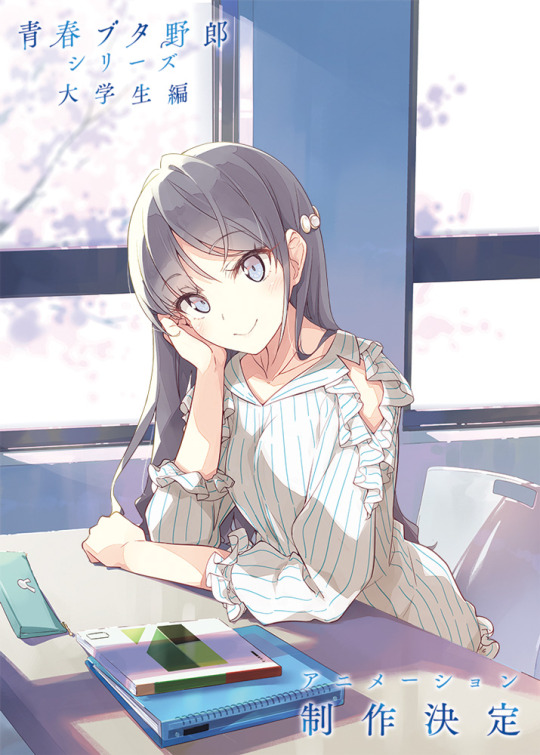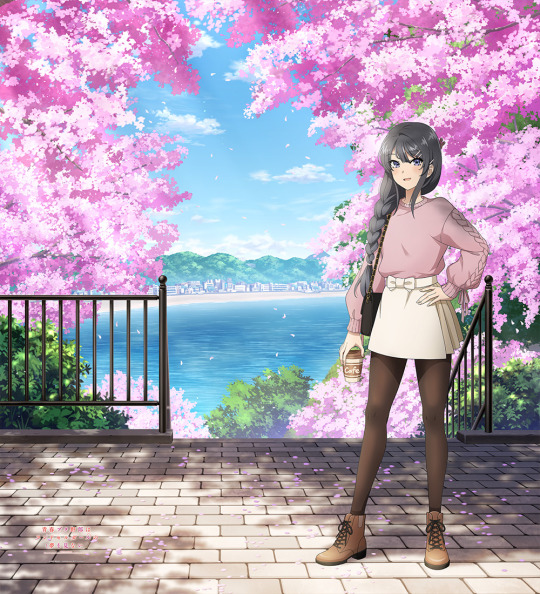#rascal does not dream of a knapsack kid
Text

#oficial art#aobuta#aobuta series#ao buta series#seishun buta yarou wa bunny girl senpai no yume wo minai#seishun buta yarou wa randoseru girl no yume wo minai#seishun buta yarou#seishun buta#seishun buta series#rascal does not dream of bunny girl senpai#rascal does not dream of a knapsack kid#rascal does not dream of logical witch#rascal does not dream#bunny senpai#bunny girl#bunny girl senpai#青ブタ#rio futaba#futaba rio#@orie0421#rascal does not dream of a sister on an outing#seishun buta yarou wa odekake sister no yume wo minai
69 notes
·
View notes
Text


ೀ ⋆𓂃 Randoseru Girl (Young Mai)
#anime figure collection#animecore#anime figure#anime figure collector#my figures#my figure collection#neetcore#otakucore#kawaii#mai sakurajima#rascal does not dream of bunny girl senpai#rascal does not dream of a sister venturing out#rascal does not dream of a knapsack kid#rascal does not dream of a dreaming girl#kawaii community#kawaii aesthetic#kawaiicore#cute aesthetic#cutecore#pink aesthetic
42 notes
·
View notes
Text
Todays rip: 04/04/2024
Mario Does Not Dream of Bunny Girl Princess
Season 5
Featured on: SiIvaGunner's Highest Quality Rips: Volume C
Ripped by Jiko Music (@jikomusic)
youtube
Requested by Memmy! (Discord)
Well, would you look at that: It's a rip request six months in the making!! I hope the wait will have been worth it, Memmy! And thank you endlessly for championing the blog so early on in its life <3.
Now - I recently spilled a lot of words regarding SiIvaGunner's fifth annual April Fools event back with Your Best Nightmario and Bowser's Finale, just four days ago. It is arguably one of the channel's all-time high points, an event that I still see discussed from time to time by random internet dwellers, even now three years later. And its clear to see why: akin to something like Mega Man Dropping January 7th‼️from earlier this year with Hella Pummel, Mario's "Death" on March 31st was an event that a huge part of the internet was already keenly aware of, one we'd all been anticipating, and one that SiIvaGunner in turn had a golden opportunity to leverage for an amazing channel event. From March 31st to April 3rd, we got to see Mario's existence as a figment be celebrated for one final day, then be entirely erased from the SiIvaGunner channel's reality at the day's end, only to then begin fighting tooth-and-nail in Your Best Nightmario for his memory to live on - a battle that, through our continued support as YouTube commenters, he was able to win in Bowser's Finale. A storybook journey, a clear beginning/middle/end structure, with a clearly-told message by the end of it all - Super Mario was back.
Yet, it still wouldn't be complete without that one last touch. Any book needs a back cover, any film its credits roll, any game a return to the title screen. Mario Does Not Dream of Bunny Girl Princess, then, was what truly closed the whole event out - and in typical SiIvaGunner fashion, did so in a deviously clever manner.
A lot of the appeal in this event as a whole, I feel, is just how easily understood the bit was at a moment's glance. Without even clicking on the videos, a viewer will notice Mario's gone, it's IMMEDIATELY apparent that something is wrong - and that likely drew a lot of eyes to the event that may have otherwise missed it. This shift in dynamics with how viewers engage with the SiIvaGunner channel is practically what this year's April Fools event, from just a few days ago, was entirely built on, yet there it was done in an incredibly tounge-and-cheek way. Because really, what it pretends to be doing almost goes against everything the channel is meant to be! The bait-and-switch, though not nearly as effective as it once was back in Season 1 with rips like Be Cool, Be Wild, and Be My Girl, IS core to what the SiIvaGunner channel is all about. It has always been a channel all about surprising you with something delightful, be that with surprise bangers like Beyond the Floating Isles, hilariously executed bits like THIS RIP WAS MADE BY TEETH GANG, or everything inbetween. There's a reason why I said that this year's event only *pretends* to be going against this - because the bit with this year's overly-explained, corny titles, is that the rips themselves still hold a secret bait-and-switch bit within them. Even when it appears to be quite literally explaining the joke, the channel hides further layers to rips just out of sight.
But what does all of that have to do with Mario Does Not Dream of Bunny Girl Princess? Well, what I'm trying to say isn't that the Season 5 April Fools day event betrayed the essence of SiIvaGunner or anything - rather, that by intentionally breaking its own rules for an entire day's worth of uploads, rules it had otherwise kept up for five whole years prior, it made this sudden subversion and the stakes of the event hit all the harder. That part may be rather obvious, sure, yet the brilliant thing here is that as a closer to the event, Mario Does Not Dream of Bunny Girl Princess employs the exact same trick in reverse order. Because after an entire day's worth of rips going against the grain, a storyline clear as crystal to follow no matter what rip you've landed on - the LAST thing anyone would've expected would be for it to close with something so seemingly low-key, standard-fare, outright NORMAL for the SiIvaGunner channel, as a single rip of Super Mario 64's Staff Roll theme. I'm sure many were expecting a grand fusion collab, some sort of CCC-esque lore video, a true mind-blowing celebration of the journey's end...and yet, to me, this return to normalcy is absolutely brilliant in so many ways, both as a subversion of those expectations, but on so many layers yet deeper. Yes, it marks the return to the SiIvaGunner status quo, it marks that Super Mario has finally been remembered - yet look beyond that, and you may just realize that Mario Does Not Dream of Bunny Girl Princess's one joke subtly hides layers of meaning, that almost recontexualize the entire event.
But, alright, let's get the ground rules set first - Mario Does Not Dream of Bunny Girl Princess is an absolutely lovely rip as is in isolation. Jiko Music is no stranger to the channel nor to the blog, having worked on several hidden-gem favorites of mine such as Trail on Powdery Snow Halation and YACKER TOILET - they very clearly know their way around a rip, and have a stellar track record over their seven years of activity. Super Mario 64's Staff Roll theme is a lovely piece of music already, one I covered a fair bit already with Staff Roll (SM64) Fusion, and Jiko Music absolutely leverages that quality to full effect here - its nostalgic percussion, melody, and instruments that sound so indescribably "Nintendo 64" push this arrangement to some truly excellent emotional heights. The original song's vocals are no longer here, akin to rips like Blessing the Dire, Dire Rains - yet through changing the lead melody's instrument from section to section, from verse to chorus, Mario Does Not Dream of Bunny Girl Princess is able to elegantly replicate how the original song's vocals would change per how many of its six vocalists were singing at any one time. It's a great rip!! ...but wait, what exactly IS the original song its arranging?
Alright, here we go - Fukashigi No Carte is the ending theme to the anime series "Rascal Does Not Dream of Bunny Girl Senpai", a story about many things, yet primarily about a mysterious girl suddenly made invisible to the world around her, dressed in the titular "bunny girl" costume. The immediate surface-level box to tick is, of course, that it's the ending theme to an anime, a credits roll to match the dramatic storyline of the event - but you may also start connecting some other dots, too, hm? Mai Sakurajima, the titular bunny girl, isn't merely made invisible to the world - she is FORGOTTEN by the public consciousness, her existence at all erased from all's mind, save for the series' protagonist who works to get the rest of the world to acknowledge her existence. Sakurajima's curse in the series is, effectively, that of a forgotten Figment - the fate that befell Mario in this very event, with us as the audience taking the role of the story's protagonist, together helping Mario win the fight against his fate by collectively remembering him.
That's a great reference all on its own, but there's another part left to discuss - the coolest part, I'd argue! Unlike comparable events such as Season 7's with ...of 2023, the Season 5 April Fools event spanned a total of five days - from the day Mario's execution was scheduled on the 31st, to April 1st itself when the event of his disappearance kicked into gear, a day-long break of April 2nd leaving his fate uncertain, the final push to resurrection on April 3rd, and the credits rolling on April 4th - which, during 2021 in particular, just so happened to be Easter. And do you notice anything in particular about this timeline of events? Executed on the 31st of March, brought back from the brink on April 3rd: Mario, just like Jesus Christ himself, AROSE ON THE THIRD DAY. Almost through sheer luck, the holiday celebrating the resurrection of Jesus Christ fell *right* next to Mario's great story of returning from public execution - allowing the whole event to come to a close on the most perfect day imaginable. And aside from Jesus himself, what is THE thing that defines Easter as a holiday?
That's right - The Easter Bunny. Bunnies. Rascal Does Not Dream of Bunny Girl Senpai.
The way every single puzzle piece clicked into place for Mario Does Not Dream of Bunny Girl Princess to work is genuinely incredible and some of the coolest shit I've ever seen the channel pull off. Not only is the rip itself a beautiful listen, it nails the landing on every single imaginable front: Subverting the expectations of the entire event's premise by its return to the status quo of rips, connecting the very lore that the SiIvaGunner channel is built on to an anime series with a rather iconic and recognizable ending theme - and connecting the event's storyline to the very foundation of the Easter holiday, and one of the Bible's most well-known events. On the very last video of the event's runtime, Mario Does Not Dream of Bunny Girl Princess made SUPER FUCKING MARIO into a Jesus allegory within the SiIvaGunner channel - and if that's the case, does that make Grand Dad the holy spirit? Is SiIvaGunner ITSELF a loose allegory for Christianity?!
...Mamma Mia, this post got long. But I hope you've been able to understand why I have so many words to say on it - so many thoughts finally able to spill over in the three years I've spent ruminating on this incredible event. Mario's return itself after Bowser's Finale was already pitch-perfect, featuring a sudden reappearance of The Reboot from Season 1 (don't get me started, I'll be here all day) - but ending it all off with something so seemingly plain, yet hiding so many layers of beauty and connective tissue, as Mario Does Not Dream of Bunny Girl Princess...it, to this day, blows me away how perfectly the pieces clicked into place.
#todays siivagunner#season 5#siivagunner#siiva#Jiko Music#Youtube#Bandcamp#super mario#super mario 64#mario 64#sm64#rascal does not dream of bunny girl senpai#rascal does not dream of a knapsack kid#rascal does not dream of logical witch#rascal does not dream#mario games#super mario 3d all stars#super mario sunshine#anime ending#anime music#anime opening#anime#easter
23 notes
·
View notes
Text
Review: Rascal Does Not Dream of a Knapsack Kid

Last year was an exciting year to be a Rascal Does Not Dream fan, with the announcement of a new anime project adapting the eighth and ninth volumes in the series, as well as the Japanese release of the latest volume—two years after the previous one! Not to mention the English release of the eighth volume, which we reviewed in conversation several months ago.
Today, we continue the tradition by bringing you a conversation-style review of the ninth volume from Hajime Kamoshida: Rascal Does Not Dream of a Knapsack Kid. Adolescent Syndrome is back and this time, it comes in the form of an elementary school kid who looks suspiciously like Mai… Besides that, Sakuta’s mother asks for a family reunion almost two years after the incident with Kaede split the parents from their children. Sounds exciting! But family dynamics are never that simple, and soon enough, Sakuta finds himself wrestling with how to forgive and find healing from the pain of their absence that still lingers.
It’s a lovely volume, with a story that’s delicate and reflective—as we’ve come to expect from the Rascal series—but surprisingly deliberate and deep as well. Give it a read if you haven’t yet! Or else beware of spoilers ahead…
Without further ado, let’s dive into Knapsack Kid!
-----
sleepminusminus: I’m going to go out on a limb and say that Knapsack Kid is my favorite volume in this series. Part of it is that this is the volume where Sakuta faces the fact that he’s almost an adult now, something I’m going to have to do once I graduate college and can’t pretend I’m a young, spry student any longer.
But this volume also excels in intentional, subtle storytelling. Case in point: at the beginning of the book, when young Mai appears, Kamoshida is careful not to say too much about her identity. Instead, she exchanges some short words with Sakuta and then leaves, intentionally creating a sense of anticipation for her return later in the book. Another example: when Mai’s mother comes to congratulate her daughter on graduating, rather than telling us directly that Mai is trying to reconcile with her, Kamoshida reveals it subtly through Mai’s earnest demeanor and an ensuing conversation with Sakuta. That conversation allows Mai to talk about her relationship with her mom and family dynamics, ideas that find parallels in Sakuta’s later interactions with his family.
Kamoshida skillfully lays the groundwork for the entire book in its opening pages. And that’s part of what gives this volume such a quiet, gentle tone, just like the previous volume, even though there’s more packed in this time around.
Twwk: I agree. Although the use of Adolescent Syndrome as a plot device once again thrusts the series into the realm of the fantastical, this volume still feels more grounded than earlier ones. I think that’s because the novel is centered on a story that most of us can relate to in some way. You don’t have to be a second fiddle sister, the victim of severe bullying, or even, as you mention, a student on the verge of entering the “real world” to identify with Mai and Sakuta here. Simply having struggled in a close relationship and not knowing how to resolve things is enough for this volume to hit hard.
I thought it was clever for Kamoshida to begin the narrative with Mai’s path forward with her mother. It certainly sets the stage for Sakuta’s journey, but I feel that it’s perhaps also emblematic of the author’s own growth as a writer. I’ve complained over and over about how contrived many of the volumes have been, and although this volume is not completely free of convenient plot devices (e.g. “I won’t ask Shouko, who probably knows the reason for this volume’s Adolescent Syndrome, because angst”), there’s surprising subtlety here too.
Knapsack Kid featured so many storylines I didn’t expect from a series that has engaged me from a heart level more than a head level, and which often hits the right emotional tones while yet leaving me rolling my eyes at how elementary the writing is. But several plot elements here—from Sakuta being at the center of the volume, to his mother coming back into the picture and the possibility of his family being made whole again, to the fact that the visible, unusual, and practically unbelievable absence of his mother was openly addressed—saw Knapsack Kid prove itself over and over again to be a more serious and tightly-knit work than past volumes. Much like its characters, the series itself seems to be growing up.

The “knapsack kid” and the rest of the characters are coming theaters!
sleepminusminus: Yes! One of the themes I appreciated most was how Kamoshida shows our need for forgiveness. We see this early on with Mai committing to forgive her mother. But Mai’s forgiveness is more dutiful than it is heartfelt, which raises all kinds of questions about the nature of forgiveness. It also leads to the more immediate question: “Can Sakuta forgive his mother?” He clearly wants to forgive her and takes steps toward doing so: when she asks to meet with Sakuta and Kaede, they jump at the opportunity.
Yet Sakuta doesn’t realize how deeply his mother’s absence has hurt him. It’s such a deep wound that, in classic Adolescence Syndrome fashion, it makes Sakuta disappear altogether. Kamoshida’s logic is this: if Sakuta can’t forgive his mother, he’s shutting the door on their relationship, cutting himself off from the person who brought him into the world. We might disagree with that logic, but the point is this: forgiveness isn’t something Sakuta can afford to take lightly. It’s a matter that is vital to his very existence. He desperately needs to forgive.
You see, all this time, Sakuta has shut away his guilt and regret about his relationship with his parents—if you can even call it a relationship! Ever since Kaede’s Adolescence Syndrome in middle school and its effects on his mother, Sakuta had to learn how to foot the bills for himself and Kaede without his parents’ financial or emotional support. All this time, he’s been in survival mode, ignoring the wounds of his parents’ neglect and suppressing his longing for a loving family. But he can’t keep running forever—he needs to turn around, face his hurt and bitterness, forgive his mother, and begin the work of reconciliation.
That’s a message we need to hear, especially in our present moment. On the one hand, we have an abundance of flowery Bible verse art reminding us of the power of forgiveness, and on the other hand, we harbor so much division in our hearts and communities. We pass by so many opportunities to live out forgiveness in a tangible way, in places where it hurts the most. We love the idea of forgiveness but scorn the actual act. It’s true that forgiving others is never easy, comfortable, or even desirable. It always comes at a cost. But the life that comes after forgiveness is more beautiful, complete, and satisfying than one spent in judgment and resentment, locking up our hurt and tossing away the key.
Twwk: Sakuta is like a damaged boiler that gives warmth to everyone around it, but is headed toward an explosion. He works and works and works for the benefit of everyone around him until he explodes. He ignores his own feelings until it’s too late. I would definitely say that I’m somewhat like Sakuta in that regard, and I think a lot of people could say the same. But part of adulthood is to be vulnerable enough to work through the hurt and weaknesses as they come up, rather than pushing them down and hoping they’ll go away, which they never do. Sakuta stored all that hurt away, in part because he had to wait for his mom to get to the point where she was willing to see Kaede again, but also as a defense mechanism. Adolescent Syndrome now gives him the opportunity to grow out of adolescence and face his challenges like an adult.
Isn’t it interesting that Adolescent Syndrome, as troubling as it is, pushes the characters to grow? To become whole? In this volume, Mai has graduated and Sakuta is now a senior, diligently studying so that he can gain admittance into the same university as her. He’s also set Kaede on the path she needs to be on. He takes care of the household. He holds down a job. In short, Sakuta is transitioning into adulthood. But the one thing he’s lacking is a restored relationship with his mom.
sleepminusminus: It is interesting! It’s also ironic because Sakuta plays a role in this volume usually reserved for the “heroines” of the series. This time he’s the one who struggles with Adolescence Syndrome, as well as the one who receives help and support from others. I love how his Syndrome involves being invisible to the world, just as Mai’s did at the beginning of the series. Their roles have been flipped, and Mai stays by Sakuta’s side, comforting him, lending him an ear, and being present as he begins to face himself.
As you said, being an adult means being vulnerable enough to uncover those wounds that fester in the deepest parts of ourselves so that we can begin the process of healing. There’s pain involved, but there’s also fulfillment in treasuring little moments of growth, anticipating better things to come, and walking alongside friends who support us on the journey. I appreciated how this novel portrays this complexity, painting a realistic picture of what it looks like for our beloved characters to grow beyond their teenage selves.
With that said, I’m anxious that the upcoming movies won’t capture the complexity that makes these novels so good. The Dreaming Girl movie suffered in this way, as you mentioned in your review, Twwk. True, that was partly because of the source material, and partly because the film rushed through the content at the expense of subtlety, leaving the characters’ motivations out of the picture. Thankfully, Venturing Out and this book are being adapted in separate movies, so there’s plenty of runtime to work with. Here’s hoping the adaptation does justice to the richness that this volume has to offer.
Twwk: I’m optimistic that the Knapsack Kid film will get it right. We keep pointing toward the subtleties in the book, but actually, it’s a relatively straightforward text with a very clear outline of events, characters we already know and love, and as you mentioned, plenty of run time (presumably) to cover one short light novel. I’m excited for it to make it to screen—and for more of the Rascal Does Not Dream series generally, as we move into the next stage of Sakuta and Mai’s lives, relationship, and story: Bunny Girl Senpai and Wisemouth Kohai in college, all grown up. - @animepopheart
And that concludes our review! What did you think about the latest Rascal volume? Excited for the upcoming anime project, or worried that it won’t live up to the hype? Let us know what you think in the comments.
=====
Rascal Does Not Dream of a Knapsack Kid is published by Yen Press.
READ: Rascal Does Not Dream reviews Vol. 1 // Vol. 2 // Vol. 3 // Vol. 4 // Vol. 5 // Vol. 6 // Vol. 7 // Vol. 8
#Anime#Light Novels#Rascal Does Not Dream of a Knapsack Kid#Seishun Buta Yarou wa Randoseru Girl no Yume wo Mina#Rascal Does Not Dream#Forgiveness#Seishun Buta Yarou#Reviews#Anime Blog#Anime Article#Light Novel Reviews#Light Novel Article#Light Novel Blog#Articles#Author: sleepminusminus#Author: TWWK#Christian Otaku#Christian Anime
34 notes
·
View notes
Text
"Rascal Does Not Dream" Double Feature review-ish thoughts

I attended the North American "Rascal Does Not Dream" double feature (subtitled edition) yesterday on March 24th. This was one of those Fathom Event things, and it served as the official North American premiere for both Rascal Does Not Dream of a Sister Venturing Out and Rascal Does Not Dream of a Knapsack Kid. At 73 minutes apiece, they're pretty damn short for movies... but I've seen even shorter in the anime world, weirdly enough. These would be the second and third movies after the "Rascal Does Not Dream of Bunny Girl Senpai" 12-episode series and its first movie sequel, 2019's Rascal Does Not Dream of a Dreaming Girl.
If you're completely unaware of this series, I implore you to ignore its admittedly awful titling convention. This is all based on a set of Japanese novels revolving around teenage (ofc) protagonists Sakuta Azusagawa and Mai Sakurajima as they contend with the bizare phenomenon that's come to be called "Puberty Syndrome" (sometimes called "Adolescence Syndrome"), in which the emotions of teenagers/pre-teens/young adults are able to somehow affect reality via quirks of theoretical quantum physics. So in this world, if someone wishes they could redo a bad experience? They might start looping said experience ala Groundhog Day. If someone feels two sides of their personality are diametrically opposed? They could literally split into two separate versions of themselves. Only somehow resolving the underlying issue can fix these bizarre sci-fi events.
The first four arcs of the TV series could be described as "A boy is made to understand and empathize with how hard it is to grow up female." After that, starting with the final arc of the TV series and up through these movies, you could describe the story as "A boy is made to understand and empathize with people who struggle with disabilities." I have tons of respect for how the series is basically all about trying to provide deeper understanding/sympathy for everyone around us.
I'm an anime-only plebe who hasn't read the books these are based on or the manga adaption, so that obviously will affect my view of the story. With that said...

Sister Venturing Out is basically the emotional sequel to the TV series' final arc, the "Sister Home Alone" story. That one contains an emotional sequence that has made me cry on MULTIPLE viewings, which I consider to be some of the highest possible praise. I have to say that Sister Venturing Out has a similarly devastating scene that flips the script on what was so painful in "Sister Home Alone" and effectively shows the pain of the OPPOSITE side of the relationship. So: major props. It's a slow-build sort of tale without the tension inherent to some of the franchise's arcs — the central gimmick of "Puberty Syndrome" barely plays a role here — but it works well at delivering on emotional payoffs and character moments. I previously felt that "Sister Home Alone" was the most emotionally intense story in the series, but Sister Venturing Out is an easy rival to it.

Knapsack Kid, on the other hand, is all about Puberty Syndrome business and the suspense of how to resolve it. Unfortunately, I don't think it works nearly as well as Sister Venturing Out because it's so clearly in need of a longer runtime to flesh out its ideas. As the story stands here, the existence of the titular "Knapsack Kid" is never even remotely explained! Series fans know that we usually expect Rio Futaba to provide some kind of quantum theory that suits the weirdness occuring, but Rio only shows up long enough to vaguely hand-wave the reality-warping shenanigans at play. Nobody ever provides any justification for why Sakuta is being guided by an all-knowing childhood version of his girlfriend. How does she know so much about what's happening? How can she jump between... realities or timelines or whatever she's doing? Why her, and more importantly, why her as a child? Shouldn’t the CHILD version of Mai know LESS about this stuff? Normally, the series would have fun explaining this; here, they want us to stop thinking and just feel it. And admittedly, the emotional moments are still pretty strong. I just think I would've felt them harder if I understood more about how and why this was all happening.
Although the series has always had its emotional moments in each story arc, the fact that these two stories have so little room to breathe means we lose out on a lot of the humor and witty dialogue that the TV series managed. There's still some of it in here; it's just not as common because we don't really have much time to spare onn comedy.
We do, however, seem to have time to spare on setting up future stories! Two plot threads are set up that do not pay off in these films but instead are events for the upcoming "University Arc." A little tease at the end of the second movie (after the post-credits scene; don't miss out on that) says that "Animation Production is Confirmed" for the University Arc — whatever the hell that means. A new TV season? There are four books so far in the "University Arc," so that seems possible. A bunch more movies? It definitely implies something longer than just one additional film. Whatever this turns out to be, I look forward to it.
#anime reviews#reviews#rascal does not dream#rascal does not dream of a sister venturing out#rascal does not dream of bunny girl senpai#rascal does not dream of a knapsack kid#university arc
4 notes
·
View notes
Text
Hiya Papaya! 👋
I really really hope they announce a second season of bunny girl senpai after the movie aired tomorrow 🙏
4 notes
·
View notes
Text

“Seishun Buta Yarou Daigakusei-hen” The Light Novel's For Gets Anime
A character visual (shown above) from the upcoming Seishun Buta Yarou wa Randoseru Girl no Yume wo Minai (Rascal Does Not Dream of a Knapsack Kid) anime film was revealed during a screening of the film. The Daigakusei-hen (University Arc) from the tenth light novel volume will be adapted for anime.
#seishun buta yarou daigakusei-hen#university arc#mai sakurajima#seishun buta yarou wa randoseru girl no yume wo minai#rascal does not dream of a knapsack kid#anime#anime news#anime film
2 notes
·
View notes
Text
When Morning Comes, I Feel Empty, Rascal Does Not Dream of a Knapsack Kid, Lumberjack The Monster, Rinjin X: Giwaku no Kanojo, Joyu wa Nakanai, MY (K)NIGHT Japanese Film Trailers
Welcome to the first trailer post of the week.
Two more trailer posts will follow.
I’m closing in on the end of SRPG Project X Zone and will start the sequel. It has proven to be great commuting gaming with easily accessible quick saves and the Nintendo 3DS’ ability to go into standby mode.
I was planning on playing lots of games over Christmas but there are still films I want to write…
youtube
View On WordPress
#Japanese Film Trailers.#Joyu wa Nakanai#Lumberjack The Monster#MY (K)NIGHT#Rascal Does Not Dream of a Knapsack Kid#Rinjin X: Giwaku no Kanojo#When Morning Comes I Feel Empty#Youtube
0 notes
Text

#oficial art#青ブタ#aobuta#ao buta series#aobuta series#ao buta#seishun buta yarou#seishun buta#rascal does not dream of bunny girl senpai#rascal does not dream of a knapsack kid#rascal does not dream of logical witch#rascal does not dream of a sister venturing out#rascal does not dream#bunny girl senpai#bunny senpai#bunny girl#seishun buta yarou wa bunny girl senpai no yume wo minai#animedia#mai sakurajima#sakurajima mai#mai aobuta#aobuta mai
51 notes
·
View notes
Text
youtube
▶️ RASCAL DOES NOT DREAM OF A KNAPSACK KID: ECCO IL PRIMO TRAILER DEL FILM!
Il nuovo capitolo dell'anime targato CLOVERWORKS (Bocchi the Rock!,My Dress-Up Darling) sbarcherà nei cinema giapponesi dal 1 dicembre.
Il film adatterà per il grande schermo la storia del 9° volume della popolare light novel, firmata da Hajime Kamoshida, che al momento in cui scrivo conta 13 volumi.
#rascal does not dream of#film#anime#manga#light novel#seishun buta yarou#rascal does not dream of a knapsack kid#seishun buta yarou wa randoseru girl no yume wo minai#aobuta#hajime kamoshida#jpop manga#cloverworks#animazione#cartoni animati#giappone#knapsack kid#randoseru girl#drama#romance#supernatural
0 notes
Text
The Rascal does not dream of a Knapsack Kid movie is going to destroy me
(The book already has)
#rascal does not dream of bunny girl senpai#bunny girl senpai#i was crying by the end of it T_T#and it does also have a very finale kind of feel#with the next books feeling like a new season#I wonder if this is why they went with movies instead of anime for books 8-9#there is not enough material for a full season#but treating knapsack kid as ordinary middle episodes wouldn’t work here#anyway I want to watch the two new movies so badly T_T
0 notes
Text

Seishun Buta Yarou wa Randoseru Girl no Yume wo Minai (Rascal Does Not Dream of a Knapsack Kid) - New goods by Curtain Damashii with new illustrations (Cherry Blossoms) for Comic Market 103.
#aobuta#seishun buta yarou wa bunny girl senpai no yume wo minai#rascal does not dream of bunny girl senpai#mai sakurajima#curtain damashii#c103#official art
59 notes
·
View notes
Text
Welcome to Doki Doki News, your source for updates in the world of anime, gaming, and otakudom, for the week of February 4th! Check out the latest episode in our player below!
Are you upset about Selen Tatsuki’s firing? Are you more excited about the Spy x Family movie or the Rascal one? Thanks for listening, and please subscribe to us on Apple, Spotify, or SoundCloud, where you can also find breaking news episodes!
Attributions:
Spy x Family [press release]
Rascal Does Not Dream [ANN]
NIJISANJI EN [ANN]
Crunchyroll [ANN]
#Anime#Anime News#VTubers#SPY x FAMILY: CODE: White#Rascal Does Not Dream of a Sister Venturing Out#Rascal Does Not Dream of a Knapsack Kid#NIJISANJI#NIJISANJI EN#Selen Tatsuki#Dokibird#Crunchyroll#Doki Doki News#Seishun Buta Yarou wa Odekake Sister no Yume o Minai#Seishun Buta Yarou wa Ransel Girl no Yume o Minai#illustrations#Anime Article#Anime Blog#Articles#Christian Anime#Christian Otaku#Christian VTubers#VTuber Article#VTuber News#Author: TWWK#SoundCloud
2 notes
·
View notes
Text

Seishun Buta Yarou wa Randoseru Girl no Yume wo Minai (Rascal Does Not Dream of a Knapsack Kid) - Shichirin Yakiniku An'an Collaboration Illustration
#aobuta#seishun buta yarou wa bunny girl senpai no yume wo minai#rascal does not dream of bunny girl senpai#mai sakurajima#collaboration#official art
56 notes
·
View notes
Text
youtube
Let's fucking GOOOOOOOOO
Rascal Does not Dream of a Sister Venturing Out AND Rascal Does Not Dream of a Knapsack Kid are getting a double-feature theatrical release in the U.S. at the end of March 2024! Tickets on sale in a few days from now!
One of the two nights it's showing will be fully dubbed in English?????? Does this mean a possible English dub is coming for the entire "Rascal Does Not Dream of Bunny Girl Senpai" franchise, including the preceding TV series and previous movie????
I haven't really talked much about this franchise on my Tumblr, but I definitely should. Ignore the awkward/dumb-sounding title(s) here; this is an intensely emotional and fascinating series.
You could describe in two ways, really:
Teenagers' emotions get intense enough to cause supernatural events, and they must overcome their struggles to solve the supernatural problem(s)
AND/OR
One dim guy is forced to learn just how difficult and horrible adolesence can be for girls.
#rascal does not dream of bunny girl#rascal does not dream of bunny girl senpai#rascal does not dream of a sister venturing out#rascal does not dream of a knapsack kid#anime#anime movies
4 notes
·
View notes
Text




☆ Sakurajima Mai // Rascal Does Not Dream of a Knapsack Kid "Graduation ver." / "Knapsack Kid"
☆ KDcolle / KADOKAWA
☆ August 2024 ¥14,850
☆ Sculpt Salamishin (Mai) / Sayori (Knapsack Kid) Paint Takeuchi Ham Cooperation TOPS co. ltd.
#mai sakurajima#seishun buta yarou wa bunny girl senpai wo yume o minai#rascal does not dream of bunny girl senpai#kdcolle#kadokawa#salamishi#sayori#takeuchi ham#tops co ltd
13 notes
·
View notes